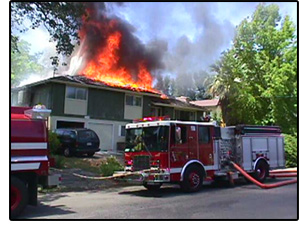Currently, the South Carolina Fire Injury Prevention Program provides residential smoke alarm installation and fire safety education throughout the state. DPH has been successful in partnering with local fire departments to provide residential smoke alarms and fire safety in homes that include the target population, young children and the elderly.
Get the Facts
In South Carolina in 2021, there were:
- 103 fire fatalities1,2
- 79 residential fires resulting in 85 deaths (83% of all deaths)2
- Smoke alarms present in 18% of home fires1
- 1,282 emergency department visits due to nonfatal fire-related injuries3
Citations
- South Carolina (SC) Office of State Fire Marshal. 2021 Fire Fatality Report
- SC Office of State Fire Marshal. SC Fire Fatality Dashboard
- SC Revenue and Fiscal Affairs Office Emergency Department Visits, 2021.
It is estimated that a working smoke alarm can reduce the risk of death in a residential fire by 40 to 50 percent.
Safety Tips
- Install a smoke alarm on each floor of your home and one outside each bedroom.
- Check the alarms every month to ensure they're working properly.
- Teach children that matches and lighters are for adult use only.
- Have a fire evacuation route in place at your home and practice it regularly.
- Never leave kerosene heaters unattended.
- Make sure that portable heaters are at least three feet away from anything that can burn.
- Turn portable heaters off when you go to sleep.
- Never fill a portable heater while it is operating or hot.
- Never use flammable liquids to start a fire in your fireplace.
- Don't empty smoldering ashes in a trashcan.
- Never leave burning cigarettes unattended. Smoking in your home increases your risk of residential fire and is harmful to you and your family's health. When you are ready to quit, call the S.C. Tobacco Quitline at 1-800-QUIT-NOW (784-8669) or visit our Tobacco Quitline webpage.
Cooking Tips to Reduce Fire
- Don't cook while wearing clothes with long loose fitting sleeves.
- Use the back burners of the stove and turn pot handles to the back of the stove while cooking and while pots remain hot.
- Never leave food, especially grease or oil, unattended on the stove.
Principles of Smoke Travel
Smoke and heat are produced by fire. Because both heat and smoke are less dense than air, both components will travel to the highest point of a room or house; thus, smoke alarms should be mounted on the ceiling. Smoke and heat will use open stairways like a chimney.
Determining the Number of Alarms for a Dwelling Unit
- Ensure there is at least one alarm on every level of your home, including the cellar.
- One smoke alarm should be installed in the immediate area of the bedrooms. If more than one sleeping area exists, locate additional detectors in each sleeping area.
- An alarm should be installed in each room where someone sleeps with a door closed.
- A smoke alarm should be installed in every room where a smoker sleeps.
Smoke Alarm Placement
- Ceiling placement is preferred over wall placement.
- Ceiling Installation: Install the alarm in the center of the room such that the alarm is closest to all points in the room. If a central mounting point is not possible, be sure to locate the detector at least four inches from the sidewall and at least two feet from any corner.
- Wall Installation: If ceiling mounting is not possible, wall mounting is an acceptable alternative. Mount the alarm so that the top of the alarm is between 4 and 12 inches from the ceiling and at least two feet from any inside corner.
Places to Avoid When Installing an Alarm
- Garages: At ignition, vehicles produce combustion and may cause a false activation.
- High air flow areas near air vents or air returns.
- Within the peaks of A-framed ceilings.
- Areas of extreme temperatures, less than 40°F or greater than 100°F.
- Dusty areas: May cause false alarms or may cause a failure in the alarm.
- Humid areas (i.e., bathrooms): Moisture or steam may cause false activation.
- Near fluorescent lighting: Fluorescent lighting may cause false activation.

